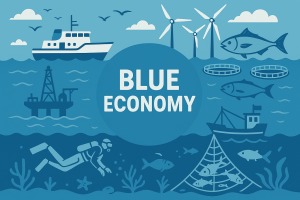🌊⚓Explore the top maritime environmental concerns today, including shipping decarbonization and clean energy solutions. Discover how the marine industry is evolving toward greener seas through innovation, regulations, and sustainability practices.
🚢 Introduction: Can the Shipping Industry Go Green?
Every year, ships transport over 11 billion tons of goods—fueling our global economy. But here’s a little-known fact: if international shipping were a country, it would be the 6th largest emitter of greenhouse gases (GHGs) in the world. 🌍
As climate change accelerates, marine and shipping industries are under pressure to reduce pollution, adopt clean energy, and support global decarbonization goals. From cleaner fuels to smart ship technologies, the tide is finally turning.
What Are Maritime Environmental Concerns?
Maritime environmental concerns refer to the ecological risks and impacts caused by human activities at sea—especially from shipping, fishing, offshore industries, and port operations.
🔍 Key Environmental Issues in Shipping:
-
🛢️ Greenhouse Gas Emissions (GHG) from ship engines
-
🧪 Ballast Water Pollution spreading invasive species
-
🧊 Arctic Ice Melting due to increased traffic and warming
-
🗑️ Marine Litter and Oil Spills
-
💨 Air Pollution (SOx, NOx, PM from heavy fuel oils)
🌐 The International Maritime Organization (IMO) adopted the Initial GHG Strategy to cut total emissions by 50% by 2050, aiming for net-zero by 2100.
♻️ Understanding Decarbonization in Shipping
⚙️ What Is Decarbonization?
Decarbonization refers to reducing carbon dioxide (CO₂) and GHG emissions across the maritime sector through alternative fuels, design improvements, and energy efficiency.
🌱 Why It Matters:
-
Combat climate change and ocean warming
-
Meet international regulations (e.g., IMO, EU ETS)
-
Protect biodiversity and coastal communities
-
Improve air quality in port cities
⚡ Clean Energy Solutions in the Marine Industry
1. Alternative Marine Fuels
-
LNG (Liquefied Natural Gas): Lower CO₂, but still fossil-based
-
Green Methanol: Renewable and cleaner than oil-based fuels
-
Ammonia (NH₃): Zero carbon but safety and toxicity issues remain
-
Hydrogen: Emission-free when produced renewably (green hydrogen)
-
Biofuels: Derived from plant or waste materials
2. Wind and Solar Assistance
-
Modern vessels use wind-assist sails, rotor sails, and solar panels to cut fuel usage.
3. Electric & Hybrid Vessels
-
Battery-powered ferries, port tugs, and short-sea shipping vessels are increasing
-
Norway leads with its fully electric ferry fleet
4. Port Electrification
-
Ports invest in shore power (cold ironing) so ships can switch off engines while docked.
🔬 Real-World Applications & Innovations
| 🌍 Country/Region | 🚢 Project/Action | 🌱 Environmental Impact |
|---|---|---|
| Norway | All-electric ferries, green hydrogen ferries | Reduction in GHGs and NOx in fjord regions |
| Singapore | Smart port initiatives & LNG bunkering hubs | Efficient routing, lower emissions |
| Japan | Wind-assisted cargo ships (e.g., K-Line vessels) | Up to 20% fuel savings |
| EU | Inclusion of shipping in the EU Emissions Trading System (EU ETS) | Financial incentive for emission reduction |
📈 Latest Trends (2024–2025)
🌐 1. Digital Twin Technology
Used to simulate ship energy use, fuel choice, and emission impact before construction or retrofitting.
📊 2. Carbon Intensity Indicator (CII)
A new IMO measure that ranks ships annually based on CO₂ emissions per cargo-mile.
🛠️ 3. Green Ship Design
-
Hull coatings that reduce drag
-
Optimized propeller and engine efficiency
-
Lightweight, recycled construction materials
💼 4. ESG Reporting
Shipping companies are now publishing Environmental, Social, and Governance (ESG) reports to attract eco-conscious investors and clients.
🎓 Educational Impact & Research Opportunities
-
Students & Researchers: Opportunities in marine engineering, environmental law, fuel chemistry, and AI in logistics
-
Academia-Industry Collaboration: Funded projects from IMO, EU Horizon, and World Bank for decarbonization R&D
-
Maritime Training: Courses now include green tech, MARPOL compliance, and fuel transition safety protocols
📊 Key Stats & Insights
-
🚢 Maritime shipping contributes ~3% of global CO₂ emissions
-
🧪 Switching to green ammonia could cut up to 700 million tons of CO₂ annually
-
🔋 The market for zero-emission vessels is expected to grow by 30% by 2030
-
🏭 Ports contribute to up to 18% of urban NOx pollution in coastal cities
❓ FAQs – People Also Ask
❓What is the biggest environmental issue in shipping?
The biggest concern is GHG emissions from burning heavy fuel oil, contributing to global warming and ocean acidification.
❓How is the shipping industry reducing carbon emissions?
Through alternative fuels, energy-efficient ship designs, shore power in ports, AI route optimization, and international regulations like IMO’s GHG strategy.
❓Are electric ships a viable solution?
Yes, for short-haul routes, ferries, and port operations, electric ships are already in use. For long-distance vessels, hybrid systems or hydrogen/ammonia may be better.
❓What role do ports play in sustainability?
Ports are investing in electrification, green infrastructure, waste recycling, and digital logistics to reduce their environmental footprint.
🧭 Sailing Toward a Cleaner, Greener Future
As oceans face unprecedented challenges, the maritime world is stepping up. Decarbonization and clean energy are not just buzzwords—they are shaping the next era of sustainable shipping.
From engineers building wind-powered vessels to policymakers setting emission limits, every stakeholder plays a role in transforming the marine industry into a leader in climate action.
🌐 Ready to navigate the future of green shipping?
Visit MaritimeEducation.com for insights, case studies, courses, and expert interviews on sustainable maritime practices.


